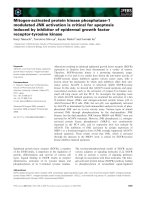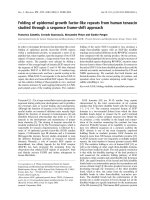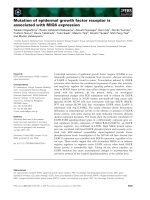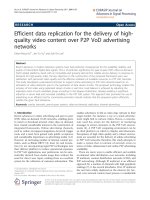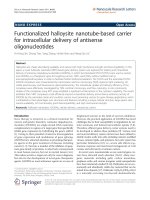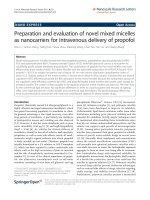Layer-by-layer polysaccharide-coated liposomes for sustained delivery of epidermal growth factor
Bạn đang xem bản rút gọn của tài liệu. Xem và tải ngay bản đầy đủ của tài liệu tại đây (3.01 MB, 7 trang )
Carbohydrate Polymers 140 (2016) 129–135
Contents lists available at ScienceDirect
Carbohydrate Polymers
journal homepage: www.elsevier.com/locate/carbpol
Layer-by-layer polysaccharide-coated liposomes for sustained
delivery of epidermal growth factor
Gabriel A.T. Kaminski a,b , Maria Rita Sierakowski a , Roberto Pontarolo b ,
Larissa Antoniacomi dos Santos a , Rilton Alves de Freitas a,∗
a
b
BioPol, Chemistry Department, Universidade Federal do Paraná, R. Coronel F. H. dos Santos, Curitiba 210–81531-980, PR, Brazil
CEB, Pharmacy Department, Universidade Federal do Paraná, Av. Prof. Lothário Meissner, Curitiba 3400–80210-170, PR, Brazil
a r t i c l e
i n f o
Article history:
Received 14 September 2015
Received in revised form 31 October 2015
Accepted 7 December 2015
Available online 17 December 2015
Keywords:
DODAB
Xanthan
Galactomannan
EGF
Layer-by-layer
Liposomes
a b s t r a c t
A three-dimensional layer-by-layer (LbL) structure composed by xanthan and galactomannan biopolymers over dioctadecyldimethylammonium bromide (DODAB) liposome template was proposed and
characterized for protein drug delivery. The polymers and the surfactant interaction were sufficiently
strong to create a LbL structure up to 8 layers, evaluated using quartz crystal microbalance (QCM) and
zeta potential analysis. The polymer–liposome binding enthalpy was determined by isothermal titration
calorimetry (ITC). The bilayer of biopolymer-coated liposomes with diameters of 165 (±15) nm, measured
by dynamic light scattering (DLS), and -potential of −4 (±13) mV. These bilayer-coated nanoparticles
increased up to 5 times the sustained release of epidermal growth factor (EGF) at a first order rate of
0.005 min−1 . This system could be useful for improving the release profile of low-stability drugs like EGF.
© 2015 Elsevier Ltd. All rights reserved.
1. Introduction
Therapies based on growth factors (GF) have promising potential in biomedical technology. In cases of chronic wounds proactive
treatment is needed for healing and GF might provide the necessary stimuli to induce wound closure (Behm, Babilas, Landthaler,
& Schreml, 2011). Of the various growth factors, epidermal growth
factor (EGF) has been first and most successfully applied for treating wounds. It is a polypeptide composed of 53 amino acids that
enhance epidermal and mesenchymal regeneration, cell motility,
and proliferation (Choi et al., 2012).
EGF could be employed to accelerate re-epithelialization, reducing risk of infection and shortening hospitalization. However, due
to short half-life, rapid dilution in the body, and the fact that EGF
receptors are overexpressed in most squamous carcinomas, brain
gliomas and breast cancers (Gedda, Olsson, Pontén, & Carlsson,
1996; Chen & Mooney, 2003), supply of exogenous EGF must be
applied in a sustained and localized fashion to be effective and
safe. The encapsulation of EGF in liposomes might be an alternative to maximize their stability and to avoid enzymatic degradation
(De˘gim et al., 2011).
∗ Corresponding author. Tel.: +55 4133613260; fax: +55 4133613260.
E-mail address: (R.A.d. Freitas).
/>0144-8617/© 2015 Elsevier Ltd. All rights reserved.
Liposomes have already been studied as delivery systems for
GF (De˘gim et al., 2011). Nevertheless, liposomes have the limitations of spilling their contents over time and aggregating (Taylor,
Davidson, Bruce, & Weiss, 2005). In order to prevent these events,
the liposomes can be coated with polymers, modulating the drug
delivery to achieve the desired release kinetics.
A very efficient technique to form polymeric coatings on twodimensional and three-dimensional systems, such as liposomes, is
Layer-by-layer (LbL), introduced by Decher (1997). This technique
consists in the alternating depositions of polycations and polyanions, generating a multilayer coating supported mainly, but not
exclusively, by the electrostatic interactions or of hydrogen bonds
(Wang et al., 1997), covalent bonds (Sun et al., 1998), hydrophobic
interactions (Lojou & Bianco, 2004) and van der Waals forces (Sato
& Sano, 2005).
In order to coat the dioctadecyldimethylammonium bromide
(DODAB) cationic liposomes, using the LbL technique, two biopolymers were chosen. Xanthan (XAN) an anionic biopolymer produced
by Xanthomonas campestris and composed of a (1 → 4)--d-glucan
cellulose backbone substituted with an acid trisaccharide in the
side chain (Jansson, Kennark, & Lindberg, 1975), and galactomannan (GMC), a neutral biopolymer from Ceratonia siliqua seeds that
is composed of a (1 → 4)--d-mannan backbone with (1 → 6)-␣d-galactose substitutions (Dea & Morrison, 1975). These polymers
interact positively and synergistically, as previously described and
130
G.A.T. Kaminski et al. / Carbohydrate Polymers 140 (2016) 129–135
measured by rheology, differential scanning calorimetry and light
scattering (Bresolin, Milas, Rinaudo, & Ganter, 1998; Khouryieh,
Herald, Aramouni, & Alavi, 2007).
In this manuscript, we evaluate a new approach for LbL-threedimensional systems structured with XAN and GMC, for sustained
release of EGF. We employed DODAB, a cationic lipid with a quaternary ammonium salt as its polar head and two 18-carbon saturated
chains, to form positively superficial charged liposomes potentiating the biopolymer LbL coating. The liposomes, including those
with coatings, were characterized, and the EGF release rates were
determined in vitro.
2. Material and methods
2.1. Polymer preparation
2.1.1. Polymer purification
XAN gum (Sigma-Aldrich) was purified by dialysis through a cellulose membrane (Sigma-Aldrich), first against 0.1 mol L−1 acetic
acid for 3 days to ensure that all the molecules would be in the
molecular conformation, and then against ultrapure water for 2
days to remove the acetic acid. GMC, from locust bean gum from C.
siliqua seeds (Sigma-Aldrich), was purified by dispersion in ultrapure water at 40 ◦ C overnight and centrifugation at 10,000 × g for
20 min at 40 ◦ C in a 4K15 C (Sigma, Osterode am Harz, Germany)
centrifuge to precipitate insoluble impurities. Ethyl alcohol (99%)
was added to the supernatant to achieve a 70% alcohol concentration, and this suspension was centrifuged at 10,000 × g for 20 min
at 5 ◦ C to precipitate the purified XAN and GMC. The polymers were
washed with 99% ethyl alcohol, centrifuged as described above and
dried at 40 ◦ C.
2.1.2. Polymer characterization
The polymers were characterized at 0.5 mg mL−1 by high performance size exclusion chromatography (HPSEC) with 0.1 mol L−1
NaNO3 and 200 ppm sodium azide at 0.4 mL min−1 as the mobile
phase at 40 ◦ C. The system was composed of a UV/vis detector, refractometer, light scattering detector at 7◦ and 90◦ and
a differential viscometer detector (Viscotek, Westborough, MA,
USA) with an OHpak SB-806 M HQ column (Shodex, New York,
NY, USA).
The persistence length (Lp ) was determined as previously
described for other galactomannans by Salvalaggio, de Freitas,
Franquetto, Koop, and Silveira (2015).
The zeta potential was determined for polymers dispersions at
0.5 mg mL−1 in ultrapure water using the electrophoretic mobility measured on a Zetasizer Nano-ZS (Malvern, Westborough, MA,
USA) at 25 ◦ C with 120 s of stabilization.
The protein quantification of purified GMC was determined by
the Hartree method (Hartree, 1972).
Infrared spectroscopy (FTIR), using an attenuated total
reflectance (ATR) mode was determined in a VERTEX 70 (BRUKER)
with 4 cm−1 of resolution and 4000–600 cm−1 (Supplementary
material S1).
2.2. Liposome preparation
Liposomes were prepared by a modified method (Alves et al.,
2009). DODAB (Sigma-Aldrich, Switzerland) was dispersed in
chloroform at 5 mmol L−1 , the solvent was removed by rotary evaporation at 40 ◦ C, and the lipid was resuspended in a 5 g mL−1 EGF
(Caregen) solution at 35 ◦ C, similar to Alves et al. (2009) and De˘gim
et al. (2011). The suspension was then submitted to sonication at
25 ◦ C in pulse mode for 5 min.
The EGF-liposome solution was diluted 1:10 in ultrapure water
and centrifuged at 10,000 × g for 20 min at 25 ◦ C. The supernatant
was discarded, and the liposomes were resuspended in 0.5 mg mL−1
XAN solution, followed by centrifugation and washing with ultrapure water. The same procedure was performed with a 0.5 mg mL−1
GMC solution.
2.3. Liposome characterization
The hydrodynamic diameters of the coated liposomes were analyzed and compared with those of the plain liposomes by dynamic
light scattering (DLS) on a NanoDLS (Brookhaven Instruments,
Holtsville, NY, USA). The uncoated liposomes and polymer-coated
liposomes were also characterized by their -potential and AFM as
described elsewhere.
The zeta potential of the liposomes was determined for
5 mmol L−1 dispersion of DODAB in ultrapure water using the electrophoretic mobility measured on a Zetasizer Nano-ZS (Malvern,
Westborough, MA, USA) at 25 ◦ C with 120 s of stabilization.
2.4. Polymer and DODAB/DODAB vesicle interaction
2.4.1. Isothermal titration calorimetry (ITC)
Experiments were performed in a VP-ITC (Microcal, Westborough, MA, USA) calorimeter with a normal cell (1.464 mL) at 25 ◦ C.
The DODAB vesicle dispersion was injected into ultrapure water or
into a polymer solution at 0.5 mg mL−1 . Each titration consisted of a
preliminary 2 L injection followed by 29 subsequent 10 L injections with 600 s intervals between each injection. The syringe tip
acted as a blade-type stirrer to ensure proper mixing at 300 rpm.
Data were collected and processed with Origin 7.0 software (OriginLab, Northampton, MA, USA).
2.4.2. Quartz crystal microbalance (QCM)
Analyses were performed in triplicate in a SRS QCM200 using the
flow cell mode. The QCM (Gold/Cr 5 MHz, SRS, Sunnyvale, CA, USA)
crystals were cleaned by immersion in 1:3 (v/v) H2 O2 :H2 SO4 for
5 min and followed by rinsing with ultrapure water. To mimic the
liposome coating process, the gold surface was modified with hexanethiol (Sigma-Aldrich) to form a hydrophobic surface and then
coated with DODAB by immersion in a 5 mmol L−1 chloroform solution similar to Morita, Nukui, and Kuboi (2006). One milliliter of
each polymer solution (0.5 mg mL−1 ) was alternately injected at
0.1 mL min−1 with a syringe pump (KD100, KD Scientific, Holliston,
MA, USA), and 1 mL of ultrapure water was injected between each
solution.
2.4.3. Atomic force microscope (AFM)
Images of each layer on the QCM crystal were obtained on a
PicoPlus Molecular Imaging microscope (Agilent, Santa Clara, CA,
USA) in the intermittent contact mode in air at 25 ◦ C with silicon
cantilevers, an oscillating amplitude of 50 to 100 nm and a resonance frequency close to 300 kHz. The dynamic tapping mode was
used with an oxide-sharpened micro-fabricated silicon -Masch
cantilever with a 4.7 N m−1 nominal spring constant and tip curvature radius of less than 10 nm. The image processing and root
mean square roughness (rms) determination were performed with
Gwyddion software (Czech Metrology Institute, Brno-sever, Czech
Republic).
2.4.4. Contact angle
The angles of the polymer substrates were determined with
OCA15+ (DataPhysics, Filderstadt, Germany) device equipped with
SCA20 software by the sessile drop method at 25 ◦ C with the delivery of 10 L ultrapure water drops onto the QCM crystal-coated
surface.
G.A.T. Kaminski et al. / Carbohydrate Polymers 140 (2016) 129–135
2.5. EGF-liposome release kinetics
the effect of its adsorption on the standard deviation of the QCM
crystal was larger (different amounts of GMC were required).
EGF release profiles were determined by HPLC quantification
using a Prominence (Shimadzu, Columbia, MD, USA) system with a
Symmetry C18 (4.6 × 250 mm, 5 m particles) column. A previously
described method (Yang, Huang, Wu, & Tsai, 2005) was adapted to
use 40% isocratic grade acetonitrile (Fluka) in 0.1% TFA at 40 ◦ C with
1 mL min−1 flow rate and 210 nm UV detection. The resulting EGF
retention time was 4.8 min.
A volume of 10 mL of Plain EGF-liposomes, XAN-coated EGFliposomes or GMC + XAN-coated liposomes, all in triplicates, were
placed in a dialysis bag (12,000 g mol−1 cut off) and immersed in
90 mL of 0.1 mol L phosphate buffer saline (PBS) at pH 5.5 and
35 ◦ C to mimic dermal delivery conditions (Wagner, Kostka, Lehr, &
Schaefer, 2003) with magnetic stirring for up to 48 h. One milliliter
aliquots were collected, at each time point, from the medium and
that volume was replaced with fresh PBS.
3. Results and discussion
3.1. Polymers
All the purified polymers exhibited a unimodal distribution as
measured by HPSEC (data not shown). After purification, the XAN
and GMC presented the molar mass (Mw ), intrinsic viscosity and
radius of gyration (Rg ) as seen in Table 1. The zeta potentials (potential) (Table 1) showed a large difference between DODAB and
XAN, suggesting that these polymers may interact with each other
electrostatically. The negative charge on the neutral GMC polymer
could be caused by attached proteins, determined as 4% (m/m), that
remained even after polymer precipitation with ethanol.
3.2. Liposomes-LbL biopolymer coating
The size of the liposomes increased (Fig. 1a) from 62 (±9) nm to
132 (±22)nm when coated with XAN and to 165 (±15) nm when
coated with the XAN and the GMC layers. The size of the liposomes,
after 48 h was 79 nm, 140 and 195 nm, respectively for plain, XAN
and XAN-GMC layers, suggesting an small increase in the size during storage of the liposomes. Although there was greater adsorption
for the GMC coating, the XAN layer represented a larger increase
in the diameter of the liposomes. This increase was most likely
because of its larger persistence length (Lp ) of 125 nm, similar to
the found by Rinaudo (2001), than of GMC (9 nm) and the Coulomb
repulsion between negatively charged XAN, resulting in pores on
the surface, which were occupied by GMC. The plain and coated
liposomes can be seen in AFM (Fig. 2).
It is clear that XAN left pores on the surface, because the first
layer only decreased the -potential of the liposomes to approximately + 35 mV (Fig. 1b). However, the first GMC layer shielded
all the positive charge from DODAB and decreased the -potential
of the liposomes to approximately −4 mV, close to the own potential of the polymer. Because GMC filled the pores left by XAN,
Table 1
Physicochemical characteristics of the polymers and the surfactant: molar mass
(Mw ), radius of gyration (Rg ) and zeta potential (-potential).
Molecules
Mw (g mol−1 )*
Rg (nm)*
-potential (mV)**
XAN
GMC
DODAB
1.03 × 10
0.26 × 106
630
69
52
–
−54.1 (±7.7)
−5.4 (±6.2)
+ 66.5 (±9.4)
6
0.1 mol L-1 NaNO3 and 200 ppm sodium azide as the mobile phase at 0.4 mL min−1
at 40 ◦ C through a Shodex OHpak SB-806 HQ column. The zeta potential was determined using the electrophoretic mobility in ultrapure water at 25 ◦ C.
*
131
3.3. Physical–chemical description of liposomes-LbL biopolymer
coating
QCM was used to verify that there were interactions between all
layers, enabling the formation and maintenance of the LbL structure. Because the liposomes were the template for the biopolymers
coating, the QCM crystal should be coated with DODAB before polymer deposition. To assure the proper DODAB coating, the crystal
was first coated with hexanethiol. Thus, the thiol group interacted strongly with gold, and its alkyl chain pointed upwards,
allowing hydrophobic interactions with the alkyl tails of DODAB.
Therefore, the cationic amino head on the surface was able to
interact with anionic XAN molecules, the first polymeric layer
injected.
The crystal topography was analyzed by AFM (Fig. 3), and the
surface contact angle was measured with ultrapure water drops
after the first layer of XAN and the first layer of GMC, on top
of XAN. QCM showed the adsorption of both polymers (Supplementary material S2), with greater adsorption for GMC. The grater
irregularity of the XAN coating, as evidenced by AFM, can explain
this finding. It appears that the Lp of XAN molecules leaves pores
that are filled by GMC, a much more flexible molecule. Because
GMC has a slightly negative charge, it can also interact with
DODAB.
The contact angle confirmed that all the layers were properly
fixed. Hexanethiol formed the most apolar surface, and DODAB
the most polar, consistent with its greater -potential. The contact
angle of the XAN layer was slightly greater than that of DODAB, indicating a less polar surface. The GMC layer, a neutral polysaccharide,
raised the surface contact angle.
As the LbL process continued, the adsorbed mass proportional
to − F, was increased (Fig. 1c). It is understandable that the electrostatic interaction is greater than other interactions. Thus, the
DODAB charge was responsible for the large initial adsorption. As
shielding decreased the effective positive charge, fewer polymers
were adsorbed. Although the adsorbed mass decreased, it was sufficient to change the -potential of the nanoparticles at each layer.
We confirmed that the LbL process was efficient for up to 4 tested
layers of each polymer (Fig. 1b).
Isothermal titration calorimetry (ITC) was used to determine the
binding enthalpy between the coating polymers, XAN and GMC,
and the DODAB vesicles. ITC analysis results in a binding isotherm
(Fig. 4) that provides precise analytical information, such as the
number of free and bound vesicles at different stages of the binding
process. It is also possible to determine the average stoichiometry
of supramolecular surfactant-polymer clusters.
Fig. 4 shows the raw signal curve (top) and the integral of the
area at each injection (bottom). The enthalpy measured in the cell
is the sum of several different energies, such as the energy of the
dilution effect and the energy of the polymers binding onto the
surfactant vesicles. The energy of the polymers binding to the vesicles is more significant than the sum of the other energies, which
represent the small energy changes that occur after all polymer
molecules are consumed.
The enthalpy curves of both polymers exhibit only one cooperative endothermic event at each injection, attributed to the binding
of the polymers to the DODAB vesicles. The Hcoat ( H attributed
to the coating of DODAB vesicles by polymer molecules) was calculated as the difference between the initial H and the average H
plateau reached.
Fig. 4a shows that each GMC molecule interacted with approximately 25 DODAB molecules in the vesicle, the molecules inside
the vesicles were not considered (neither the flip-flop effect), with
132
G.A.T. Kaminski et al. / Carbohydrate Polymers 140 (2016) 129–135
Fig. 1. (a) Gaussian distribution of nanoparticles showing the increase in hydrodynamic diameter (Dh) caused by the polymer coating, determined by DLS at 90◦ . (b)
Zeta potential determined by electrophoretic mobility at 25 ◦ C for LbL-coated liposomes after each layer. Bars denote the standard deviation. (c) Frequency shift tendency
determination (n = 3) by QCM for LbL with polymers injected at 0.1 mL min−1 . The crystal was washed with ultrapure water between polymer injections.
a binding enthalpy of 17.6 kJ mol−1 of DODAB. At ∼50 mol L−1 of
DODAB all GMC molecules were consumed and there is a surplus
of free DODAB vesicles.
In the ITC plot of the DODAB vesicles titration in the XAN
solution (Fig. 4b), a plateau is observed between surfactant concentrations of 600 and 900 mol L−1 . At these concentrations,
all XAN molecules were consumed; each XAN molecule coats
∼1500 DODAB molecules in the vesicle with a coating enthalpy
of 26.4 kJ mol−1 of DODAB. The small remaining enthalpies with
further liposomes addition tend to zero and might be attributed to
associations in other larger colloidal systems.
To better comprehend the polymer coatings of the DODAB liposomes, the number of surfactant (Ntot ) molecules that formed each
liposome was calculated by the following equation:
G.A.T. Kaminski et al. / Carbohydrate Polymers 140 (2016) 129–135
133
Fig. 2. AFM topography 4 × 4 m images of the LbL process on a QCM crystal. (a) Gold surface; (b) Hexanethiol; (c) DODAB; (d) XAN; (e) GMC.
Fig. 3. AFM topography image of (a) Plain liposomes; (b) XAN-coated liposomes; (c) GMC + XAN-coated liposomes.
Ntot =
4
d/2
2
+4
a
d/2 − h
2
(1)
where d is the liposomes diameter, 62 nm determined by DLS, h
is the bilayer thickness, 4 nm (Correia, Petri, & Carmona-Ribeiro,
2004) and a is the surfactant head group area. It was found that
approximately 31,000 DODAB molecules associate to form each
colloidal structure. Therefore, approximately 1250 GMC molecules
coated each liposome while, approximately, only 20 molecules of
XAN.
Possible explanations for this great difference include the
electrostatic repulsion between adsorbed XAN molecules on the
liposome surface, hindering the adsorption of newly arrived XAN
molecules. The XAN molecules used in this research are larger than
the GMC molecules, they have 4 times the molar mass. Also, the
longer Lp of XAN molecules play a role in the lack of organization
of the adsorbed molecules, while the GMC molecules can adjust
better on the surface and even interact with each other.
The large enthalpy observed in our study suggests that the
charged sites of XAN molecules are strongly attracted to the DODAB
liposomes. The larger heat exchange of DODAB-XAN, compared
with that of DODAB-GMC, is likely due to the ion-exchange interactions between DODA+ and the negative sites on XAN.
3.4. Release kinetics
After confirming the formation and structure of the liposomes
coated with biopolymers and the physical-chemical parameters of
the coating, EGF was encapsulated in the system. The entrapment
efficiency was 72 ± 3%. The efficiency was determined by HPLC
quantification through the direct method of lysing liposomes with
3% Triton X-100, described by Liu, Yang, Liu, and Jiang (2008) and
an indirect method that measured the EGF in the supernatant of
centrifuged liposomes.
The kinetics data were treated with the Berens and Hopfenberg
(1978) model (Eq. (2)), suitable for spheres, which showed confidence intervals above 99% for the 3 systems:
134
G.A.T. Kaminski et al. / Carbohydrate Polymers 140 (2016) 129–135
Fig. 4. Thermogram (top) and binding isotherm (bottom). The latter resulted from the integration of the ITC peaks in the former, which were at 25 ◦ C. (a) DODAB liposomes
titrated in a solution of GMC at 0.5 mg mL-1 (b) DODAB liposomes titrated in a solution of XAN at 0.5 mg mL-1 .
Mt
=1−
M∞
6
F
i
2
n=3
1
n2
exp
−4
2 n2 Dt
d2
1.0
−
R exp (−kx)
0.8
where D is the diffusion coefficient, k is the first-order relaxation
constant, F and R are the fractions of sorption contributed by Fickian diffusion and chain relaxation, respectively, d is the diameter of
the nanoparticle and t is time.
Each layer of coating contributed to the release kinetics, as seen
in Fig. 5. The plain liposomes presented a constant drug delivery
rate (k) of 0.025 min−1 , and the XAN layer reduced the delivery rate
to 0.016 min−1 , 1.6 times longer. For the liposomes coated with one
layer of both polymers, the delivery k decreased to 0.005 min−1 , 5
times smaller than the rate of the plain liposomes.
Non-linear least square fitting routine was used to fit the release
of EGF from the nanoparticles into the above model. This model
describes the release behavior in terms of Fickian and non-Fickian
contributions. As the coating took place the R parameter became
dominate. When the last term of the equation is switched to
−X/ , it provides the characteristic relaxation time ( ).
The coating thicknesses (L) of the layers were determined as
the difference between the nanoparticles hydrodynamic radius
(Fig. 1a). The Mt /M∞ was plotted against the square root of t/L2
0.6
in cm2 to provide the EGF diffusibility (D), the angular coefficient, in
all nanoparticles according to Vogt, Soles, Lee, Lin, and Wu (2004).
The and the D values were plotted together against the coating
layers and can be seen in Supplementary material (S3).
Mt/M
(2)
0.4
0.2
0.0
0
60
120
180
240
300
360
420
480
Time (min)
Fig. 5. The tendency profile in vitro of EGF from the nanoparticles in PBS at pH 5.5
and 35 ◦ C by dialysis. • Plain liposomes, XAN coated liposomes and XAN + GMC
coated liposomes. Bars denote the standard deviation (n = 3).
The plain liposomes relaxation time (t) was found to be 40 min,
the XAN layer increased to 60 min and the XAN and GMC coatings
increased to 195 min. It can be noticed that the XAN layer contributed to a 50% increase in the nanoparticles sustained release,
while the GMC over the XAN layer increased it in almost 400%. One
additional layer of each polysaccharide XAN-GMC reduced completely the drug delivery to zero during 480 min of evaluation.
G.A.T. Kaminski et al. / Carbohydrate Polymers 140 (2016) 129–135
As the coating became thicker, the relaxation of the polymers in
the coating layers became more important for the release of EGF.
This way, as D decreased, increased exponentially.
4. Conclusion
The natural interaction between XAN and GMC was demonstrated to be sufficiently strong to provide LbL structure for up to 8
biopolymer layers. The association of the anionic XAN and the neutral GMC for liposomes coating provided a synergistic effect that
built a cohesive nanoparticle capable of increasing 5 times the sustained delivery of EGF with only one layer of each polymer. The EGF
release from the nanoparticles was attributed to the polymer chains
relaxation by the use of the diffusion and relaxation model. The
use of these natural polysaccharides in three-dimensional delivery
systems provides biocompatibility, ease and abundance at low cost.
Acknowledgements
We acknowledge the Brazilian funding agencies CNPq (Conselho Nacional de Pesquisa, process no. 477275/2012-5 and
300343/2010-8, Fundac¸ão Araucária, project 23643, convênio
447/2012, and Rede Nanobiotec/Capes-Brazil, project 34, for financial support. We are grateful to Dra. Leila Beltramini (Instituto de
Física de São Carlos) for ITC analysis, Dr. Watson Loh (Instituto
de Química UNICAMP) for thermodynamic discussion aid and Dr.
Lionel Gamarra (Instituto Cérebro, Hospital Albert Einstein) for potential analysis.
Appendix A. Supplementary data
Supplementary data associated with this article can be found, in
the online version, at doi:10.1016/j.carbpol.2015.12.014.
References
Alves, J. B., Ferreira, C. L., Martins, A. F., Silva, G. A. B., Alves, G. D., Paulino, T. P., et al.
(2009). Local delivery of EGF-liposome mediated bone modeling in orthodontic
tooth movement by increasing RANKL expression. Life Sciences, 85, 693–699.
Behm, B., Babilas, P., Landthaler, M., & Schreml, S. (2011). Cytokines, chemokines
and growth factors in wound healing. Journal of the European Academy of
Dermatology and Venereology, 26, 812–820.
Berens, A. R., & Hopfenberg, H. B. (1978). Diffusion and relaxation in glassy
polymer powders: 2. Separation of diffusion and relaxation parameters.
Polymer, 19, 489–496.
Bresolin, T. M. B., Milas, M., Rinaudo, M., & Ganter, J. L. M. S. (1998).
Xanthan–galactomannan interactions as related to xanthan conformations.
International Journal of Biological Macromolecules, 23, 263–275.
Correia, F. M., Petri, D. F. S., & Carmona-Ribeiro, A. M. (2004). Colloid Stability of
Lipid/Polyelectrolyte Decorated Latex. Langmuir, 20, 9535–9540.
135
Chen, R. R., & Mooney, D. J. (2003). Polymeric growth factor delivery strategies for
tissue engineering. Pharmaceutical Research, 20, 1103–1112.
Choi, J. K., Jang, J.-H., Jang, W.-H., Kim, J., Bae, I.-H., Bae, J., et al. (2012). The effect of
epidermal growth factor (EGF) conjugated with low-molecular weight
protamine (LMWP) on wound healing of the skin. Biomaterials, 33, 8579–8590.
Dea, I. C. M., & Morrison, A. (1975). Chemistry and interactions of seed
galactomannans. Advances in Carbohydrate Chemistry and Biochemistry, 32,
241–312.
Decher, G. (1997). Fuzzy nanoassemblies: Toward layered polymeric
multicomposites. Science, 277, 1232–1237.
De˘gim, Z., C¸elebi, N., Alemdaro˘glu, C., Deveci, M., Öztürk, S., & Özo˘gul, C. (2011).
Evaluation of chitosan gel containing liposome-loaded epidermal growth
factor on burn wound healing. International Wound Journal, 8, 343–354.
Gedda, L., Olsson, P., Pontén, J., & Carlsson, J. (1996). Development and in vitro
studies of epidermal growth factor–dextran conjugates for boron neutron
capture therapy. Bioconjugate Chemistry, 7, 584–591.
Hartree, E. F. (1972). Determination of protein: A modification of the lowry method
that gives linear photometric response. Analytical Biochemistry, 48, 422–427.
Jansson, P. E., Kennark, L., & Lindberg, B. (1975). Structure of the extracellular
polysaccharide from Xanthomonas campestris. Carbohydrate Research, 45,
275–282.
Khouryieh, H. A., Herald, T. J., Aramouni, F., & Alavi, S. (2007). Intrinsic viscosity
and viscoelastic properties of xanthan/guar mixtures in dilute solutions: Effect
of salt concentration on the polymer interactions. Food Research International,
40, 883–893.
Liu, Y., Yang, Y., Liu, X., & Jiang, T. (2008). Quantification of pegylated liposomal
doxorubicin and doxorubicinol in rat plasma by liquid
chromatography/electrospray tandem mass spectroscopy: Application to
preclinical pharmacokinetic studies. Talanta, 74, 887–895.
Lojou, É., & Bianco, P. (2004). Buildup of polyelectrolyte-protein multilayer
assemblies on gold electrodes. Role of the Hydrophobic Effect. Langmuir, 20,
748–755.
Morita, S., Nukui, M., & Kuboi, R. (2006). Immobilization of liposomes onto quartz
crystal microbalance to detect interaction between liposomes and proteins.
Journal of Colloid and Interface Science, 298, 672–678.
Rinaudo, M. (2001). Relation between the molecular structure of some
polysaccharides and original properties in sol and gel states. Food
Hydrocolloids, 15, 433–440.
Salvalaggio, M. O., de Freitas, R. A., Franquetto, E. M., Koop, H. S., & Silveira, J. L. M.
(2015). Influence of the extraction time on macromolecular parameters of
galactomannans. Carbohydrate Polymers, 116, 200–206.
Sato, M., & Sano, M. (2005). Van der Waals layer-by-layer construction of a carbon
nanotube 2D network. Langmuir, 21, 11490–11494.
Sun, J., Wu, T., Sun, Y., Wang, Z., Zhang, X., Shen, J., et al. (1998). Fabrication of a
covalently attached multilayer via photolysis of layer-by-layer self-assembled
films containing diazo-resins. Chemical Communications, 17, 1853–1854.
Taylor, T. M., Davidson, P. M., Bruce, D. B., & Weiss, J. (2005). Liposomal
nanocapsules in food science and agriculture. Critical Reviews in Food Science
and Nutrition, 45, 587–605.
Vogt, B. D., Soles, C. L., Lee, H.-J., Lin, E. K., & Wu, W.-L. (2004). Moisture absorption
and absorption kinetics in polyelectrolyte films: Influence of film thickness.
Langmuir, 20, 1453–1458.
Wagner, H., Kostka, K.-H., Lehr, C.-M., & Schaefer, U. F. (2003). pH profiles in human
skin: Influence of two in vitro test systems for drug delivery testing. European
Journal of Pharmaceutics and Biopharmaceutics, 55, 57–65.
Wang, L. Y., Wang, Z. Q., Zhang, X., Shen, J. C., Chi, L. F., & Fuchs, H. (1997). A new
approach for the fabrication of an alternating multilayer film of
poly(4-vinylpyridine) and poly(acrylic acid) based on hydrogen bonding.
Macromolecular Rapid Communications, 18, 509–514.
Yang, C.-H., Huang, Y.-B., Wu, P.-C., & Tsai, Y.-H. (2005). The evaluation of stability
of recombinant human epidermal growth factor in burn-injured pigs. Process
Biochemistry, 40, 1661–1665.

